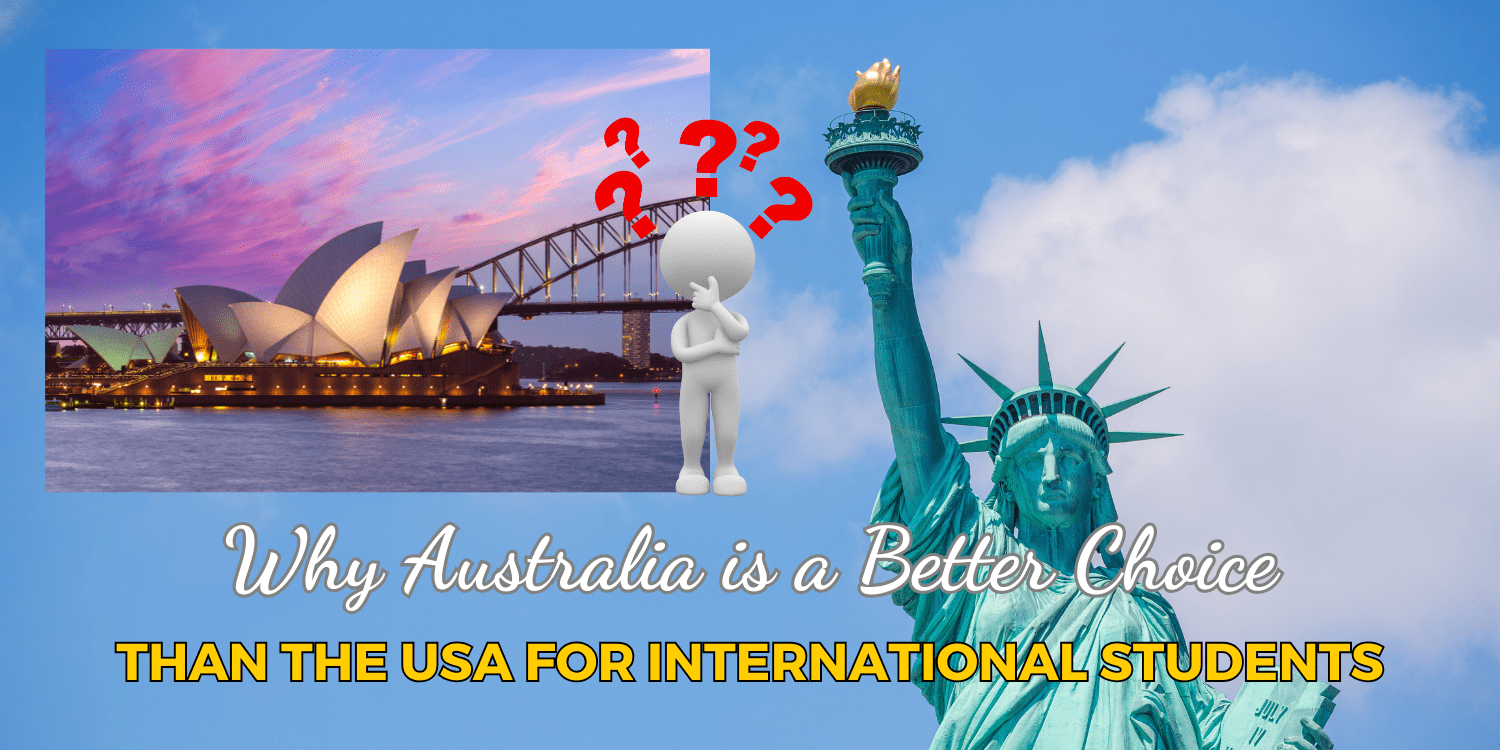Introduction
Deciding where to study abroad is one of the biggest choices for international students. While both Australia and the United States are popular destinations, Australia has become the preferred option for many. With its affordable education, post-study work opportunities, safe environment, and relaxed lifestyle, Australia is consistently ranked as one of the top study-abroad destinations.
In this guide, we compare Australia and the USA across education, costs, lifestyle, and career opportunities and explain why Australia often comes out on top.
Education System: Streamlined and Career-Focused
Australia
Australian universities emphasize independent learning, practical applications, and research-based education. Most undergraduate degrees take just three years, meaning students graduate faster and spend less on tuition compared to the USA.
Australia also has a strong vocational education and training (VET) sector, offering hands-on qualifications that are highly valued by employers worldwide.
United States
The American system is longer and more expensive. Undergraduate degrees usually take four years and include general education courses that may not always align with career goals. While the flexibility can be a plus, many students find the extra time and cost unnecessary compared to Australia’s streamlined approach.
Tuition Fees and Living Costs: Australia is More Affordable
Australia
International students in Australia typically pay AUD 20,000 – 45,000 per year, which is much lower than many U.S. universities. On top of that, students can work up to 48 hours per fortnight during the semester and full-time during breaks, helping offset expenses.
Living costs vary by city, but even in major hubs like Sydney and Melbourne, students find ways to balance work and study. Cities such as Brisbane, Adelaide, and Perth are even more affordable, making Australia budget-friendly.
United States
In the U.S., tuition fees can exceed USD 50,000 per year at private universities. Public universities are cheaper, but still costly for international students. Living in major cities like New York or San Francisco adds significant expenses, making the U.S. one of the most expensive study destinations in the world.
Work and Post-Study Opportunities: Australia Offers More Flexibility
Australia
Australia makes it easier for international students to gain valuable work experience. Many students take part-time jobs in retail, hospitality, and services.
After graduation, the Temporary Graduate Visa (subclass 485) allows students to stay and work for two to four years, depending on their qualification. This is a major advantage, as it provides a clear pathway to long-term career growth and even permanent residency.
United States
In the U.S., students face strict work restrictions. Most can only work on-campus during their studies. After graduation, the Optional Practical Training (OPT) program allows for 12 months of work, with a possible 24-month STEM extension. However, long-term opportunities depend heavily on winning an H-1B visa lottery, which is highly competitive and uncertain.
Lifestyle and Student Experience: Australia’s Laid-Back Appeal
Australia
With its multicultural society, outdoor lifestyle, and welcoming student communities, Australia is one of the most student-friendly countries in the world. From beaches to national parks, students enjoy a healthy balance between study and leisure. Public transport is reliable in most cities, and universities provide strong student support networks.
Australia is also consistently ranked among the safest countries for international students, offering peace of mind for students and their families.
United States
While the U.S. offers diverse cultural experiences and iconic cities, it also comes with higher living stress, more competition for jobs, and less security regarding visas. Students may enjoy vibrant campus life, but many face challenges adjusting to high costs and complex immigration policies.
Career Prospects: Australia Provides Clearer Pathways
Australia
Graduates from Australian universities are highly employable worldwide, and the local job market has strong demand in industries like healthcare, IT, engineering, and business. The combination of post-study work rights and pathways to permanent residency makes Australia a long-term destination, not just a study stop.
United States
Although U.S. degrees, especially from elite institutions, are prestigious, many international students face visa uncertainties after graduation. Employer sponsorship is required, and the limited number of visas makes it difficult for students to remain in the U.S. long term.
Final Verdict: Australia is the Smarter Choice
Both Australia and the U.S. offer excellent universities and cultural experiences. But when it comes to affordability, work opportunities, lifestyle, and career security, Australia stands out as the better option for international students.
If your priority is high-quality education, financial sustainability, and long-term career growth, Australia is the destination to choose.
How SOL Edu & Migration Can Help You
Starting your study journey in Australia can feel overwhelming, but that’s where SOL Edu & Migration makes a difference. Our expert team supports you at every stage from choosing the right course and university, to guiding you through the visa process, and even helping you settle into life in Australia.
With years of experience assisting international students, we understand the challenges you may face and are here to make your transition smooth and stress-free. Whether you need advice on course changes, post-study work visas, or pathways to permanent residency, SOL Edu & Migration will walk beside you every step of the way.
👉 Begin your Australian journey with confidence choose SOL Edu & Migration as your trusted partner in education and migration.

